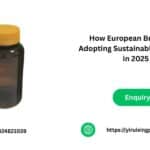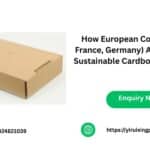2025 Packaging Trends: Sustainable & Minimalist Designs – As we move into 2025, the packaging field is going through a transformative move. With increasing environmental concerns and a consumer base that is more aware than ever, the demand for sustainable and minimalist packaging designs is increasing. Brands are rethinking their packaging strategies, not just to meet environmental regulations, but to appeal to a new generation of eco-conscious shoppers. In this blog, we discover the top packaging trends of 2025 with an attention to sustainability and minimalism, why they matter, and how businesses can adapt to stay ahead.
Table of Contents
ToggleThe Growth Of Sustainable Packaging
1. Eco-Friendly Materials
In 2025, sustainable packaging starts with materials. Brands are not only using paper, cardboard, bamboo, and plant-based plastics to replace plastic, but they are also choosing materials that are:
- Biodegradable
- Recyclable
- Compostable
- Post-consumer waste products
Mono-material packaging (there is a lot of movement in mono-material packaging, making recycling much easier with one type instead of various layers of different materials)
2. Reusables & Refilled Containers
Whereas companies have typically designed products and packaging for a single use, a rising number of brands are developing products in containers that can be refilled and reused. For example, beauty brands use refill pod systems, and food brands have refill stations for bulk goods. Not only does it cut down waste, but this builds brand loyalty as you are encouraging buyers to return and purchase refill products/services.
3. Carbon-Neutral & Low-Impact Prints
Another big trend in 2025 is the rise of carbon-conscious printing. Brands are adopting –
- Soy or water-based inks.
- Digital printing to reduce surplus production.
- Using less color.
All of this reduces carbon footprint and reduces the environmental impact of products and packaging while aligning core brand values of sustainability.
Accepting Minimalist Packaging Designs
Minimalism is not simply about aesthetics – it’s about apparent purpose, clarity, and sustainability. More brands are including minimalism in packaging so they can ensure they are communicating authenticity and reducing how much material they use.
1. Less is More
By 2025, consumers will be drawn to simple packaging that conveys trust and style. Packaging designs are moving away from flashy graphics and moving toward –
- Flat colors
- Simple fonts
- Clear messaging
Not only does this improve visual appeal, but it also lowers production complexity and waste.
2. Smart Structural Design
Minimalist packaging also extends to structure. Firms are investing in space-efficient packaging, lowering void fill, and ensuring products fit snugly within containers. This saves storage space, lowers shipping expenses, and reduces carbon emissions.
3. Transparent Branding
Genuine and clean labeling is important in 2025. Instead of overwhelming consumers with information, brands are using packaging as a way to educate and build trust. QR codes are frequently used to give buyers deeper access to product information, like sourcing, sustainability practices, and rules for recycling.
The Role Of Technology In Sustainable And Minimalist Packaging
Technology is a main driver in the packaging transformation. In 2025, many tech-forward innovations are helping brands integrate sustainability with simplicity.
1. Smart Packaging
Smart packaging uses NFC chips, QR codes, and augmented reality to share extra information without additional packaging. A simple box can be simple and sleek while offering a full brand story or even information about how to use the product, with a scan.
2. AI-Driven Packaging Design
Artificial intelligence is helping packaging designers create the most efficient designs while reducing materials, extending shelf life, and increasing efficiency across the supply chain. AI tools can help the designer simulate how their packaging will be in different situations, removing some of the trial-and-error waste.
The Driving Force of Consumer Demand
The demand for sustainable packaging and minimalistic packaging is driven by Gen Z and Millennial consumers, and they certainly do their fair share of research. Gen Z and Millennial customers are very invested in social and environmental values and are willing to spend more for eco-friendly brands. Packaging is a major part of that perception. A study recently published showed us that –
- 72% of consumers say packaging design is a factor in their final purchase decision.
- 63% of consumers are more likely to purchase a product with eco-friendly packaging.
- 56% of consumers associate minimalistic packaging with high-quality brands.
The numbers above speak for themselves, with more and more evidence pointing out that if you do not adapt your business, you will fall behind.
Why Switch to Sustainable & Minimalist Packaging?
If you were to take on a sustainable & minimalistic packaging change by 2025, there are real advantages.
- Reduce your Expenses – By reducing your materials, printing, and overall package size, you are vastly reducing your production and operational costs.
- Stronger Brand Image – Minimalist, eco-conscious packaging aligns with the values of contemporary customers and improves brand trust.
- Regulatory Compliance – With governments approving stricter environmental laws, sustainable packaging ensures compliance and avoids penalties.
- Competitive Advantage – Early adopters of sustainable trends position themselves as industry leaders.
Conclusion
As we look ahead to 2025, the convergence of sustainability and minimalism in packaging design is not just a style choice; it is a business necessity. From using eco-friendly materials to simplifying design language and embracing technology, these trends are transforming how products are presented and perceived. For businesses seeking to improve their packaging in 2025, Yiruixing Packaging provides creative, sustainable, and beautifully minimal custom solutions customized to meet modern demands.
FAQs
Why is sustainable packaging so important in 2025?
Sustainable packaging is important due to rising environmental concerns, stricter regulations, and a growing number of customers selecting brands based on eco credentials. It is not just a trend; it is a need.
What are examples of minimalist packaging?
Minimalist packaging frequently features simple typography, a neutral color palette, clean lines, and limited material use. Examples include plain kraft paper wrapping, clear labels, or monocolor boxes with small logos and important information only.
How can small businesses execute these trends affordably?
Begin with eco-friendly materials such as recycled paper or corrugated cardboard, simplify the packaging design, and avoid unnecessary printing. Partner with suppliers who provide low-MOQ sustainable solutions and explore digital printing for affordability.
What fields benefit the most from minimalist and sustainable packaging?
Beauty, food and beverage, electronics, fashion, and health & wellness brands benefit most, as customers in these industries are particularly drawn to clean looks and sustainability messaging.





